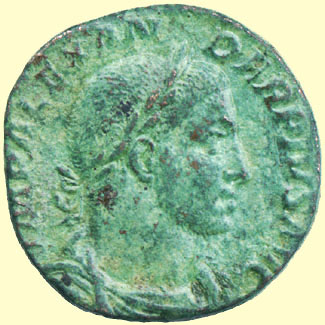 Gallery Thumbs -
Previous Image -
Next Image
Gallery Thumbs -
Previous Image -
Next Image
Reverse of This Coin - Coin List
Beautiful Patina on a Brass Sestertius of Severus Alexander
The lovely light green patina is actually corrosion that has formed over the years. Having completely covered the coin, this corrosion has turned from the role of destroyer of the metal to its protector, now sealing out moisture and other forms of chemical attack.
Even though patination is a form of corrosion and therefore a destructive force, collectors highly prize ancient coins with attractive patinas. While technically lowering the grade of a coin and obscuring detail by covering it with encrustation, a well formed patina may actually highlight what little detail is left on a worn coin, transforming it into a new work of art wrought not by striking metal up into a relief image, but by painting the surface with delicate hues. If you are a collector of MS graded U. S. Morgan dollars, you might wish to make a contemplative visit to a dealer in ancients or browse the contents of this CD or Web site. Does not the face of Antoninus call out to your collecting heart at a mere thirty five dollars for a masterpiece such as this?
The light green color indicates that the mineral forming the corrosion is largely malachite, a carbonate of copper. Copper oxides will tend to give a coin a brown or black patina, while copper sulfate, only rarely seen in natural patinas, imparts a brilliant blue to the surface color.
 Malachite was an ore of copper that was easy to mine and smelt by early humans. The history of its use goes back to the earliest of human civilizations. being mined during the time of the first great cities of c. 3000 to 3500 B.C. This Sestertius of Severus Alexander was probably lost by someone fleeing from the terror of invasion or civil war during the middle of the Third Century A.D. It probably fell to the Earth, who sought to reclaim its own and turn this little piece of copper bearing metal into a mineral again until it was found by a lucky hunter of ancient artifacts and found its way into the author's collection.
Malachite was an ore of copper that was easy to mine and smelt by early humans. The history of its use goes back to the earliest of human civilizations. being mined during the time of the first great cities of c. 3000 to 3500 B.C. This Sestertius of Severus Alexander was probably lost by someone fleeing from the terror of invasion or civil war during the middle of the Third Century A.D. It probably fell to the Earth, who sought to reclaim its own and turn this little piece of copper bearing metal into a mineral again until it was found by a lucky hunter of ancient artifacts and found its way into the author's collection.
This Sestertius of Severus Alexander is not a particularly large diameter piece, being somewhat smaller in diameter than a U.S. fifty Cent piece and a Susan B. Anthony Dollar. The image at right below will appear to be the same size as the actual coin on a 14 inch monitor set at 640 x 480 resolution.
Next Image In Gallery
Previous Image in Gallery
Return to Gallery Thumbs
Coin Glossary
Return to Roman Coins Table of Contents - Up one level.
Return to History and Technology Back Pages - The home page for this entire site.
 Malachite was an ore of copper that was easy to mine and smelt by early humans. The history of its use goes back to the earliest of human civilizations. being mined during the time of the first great cities of c. 3000 to 3500 B.C. This Sestertius of Severus Alexander was probably lost by someone fleeing from the terror of invasion or civil war during the middle of the Third Century A.D. It probably fell to the Earth, who sought to reclaim its own and turn this little piece of copper bearing metal into a mineral again until it was found by a lucky hunter of ancient artifacts and found its way into the author's collection.
Malachite was an ore of copper that was easy to mine and smelt by early humans. The history of its use goes back to the earliest of human civilizations. being mined during the time of the first great cities of c. 3000 to 3500 B.C. This Sestertius of Severus Alexander was probably lost by someone fleeing from the terror of invasion or civil war during the middle of the Third Century A.D. It probably fell to the Earth, who sought to reclaim its own and turn this little piece of copper bearing metal into a mineral again until it was found by a lucky hunter of ancient artifacts and found its way into the author's collection.
 Gallery Thumbs -
Previous Image -
Next Image
Gallery Thumbs -
Previous Image -
Next Image